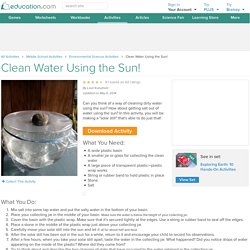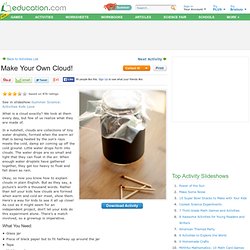

LAB SAFETY Video - I Think School.com. PosterThePartsofaScientistGirlwDeeperSkinTones. Clean Water Using the Sun! Can you think of a way of cleaning dirty water using the sun?

How about getting salt out of water using the sun? In this activity, you will be making a "solar still" that's able to do just that! What You Do: Mix salt into some tap water and put the salty water in the bottom of your basin. Place your collecting jar in the middle of your basin. What Happened? When water evaporates it leaves all of its impurities behind. Lauri Kubuitsile is a former science teacher turned fulltime writer living in Botswana. How to Make a Cloud. What is a cloud exactly?

We look at them every day, but few of us realize what they are made of. In a nutshell, clouds are collections of tiny water droplets, formed when the warm air that is being heated by the sun's rays meets the cold, damp air coming up off the cold ground. Little water drops form into clouds. The water drops are so small and light that they can float in the air. When enough water droplets have gathered together, they get too heavy to float and fall down as rain.
Okay, so now you know how to explain clouds in plain English. What You Need: Glass jar Piece of black paper but to fit halfway up around the jar Tape Hot tap water Match Ice cubes in a plastic bag What You Do: Tape the piece of black paper around the bottom half of the jar. Have an adult light the match and hold it over the jar opening for a few seconds. Questions to ask your child: What happened to the air in the jar? What did the ice cubes do? What else did you notice? So what happened? Clean Water Using the Sun! Lesson_030_handout. The effect of heat: simple experiments with solids, liquids and gases. By Erland Andersen and Andrew Brown Changing properties 1) Make your own thermometer: gases expand when heated This experiment introduces the idea that heat makes gases expand.

Students will make their own thermometer based on this principle. Safety note: teachers should perform the step involving scissors. Materials Per group of pupils: A rigid plastic bottle with a lid Play dough or modelling clay, e.g. Procedure What happens? The heat from your hand warms the air inside the bottle. 2) Watch a knitting needle grow: solids also expand when heated In the previous experiment, the heat from a pair of hands was sufficient to expand the gas in the bottle considerably. Safety note: because naked flames and sharp objects are used in this experiment, it is advisable to perform it as a demonstration.
Push the cork halfway into one of the bottles. Changing states So far, students have seen what happens when we heat solids and gases: they expand. 3) Liquid to gas: evaporation on your finger How? Review. Heat - Ball & Ring Experiment. Water cycle song. KS3 Bitesize Science - Particle model : Revision. States of Matter: basics from Phet. Changes of state key words wordle. Video about the particle model from BBC Bitesize.